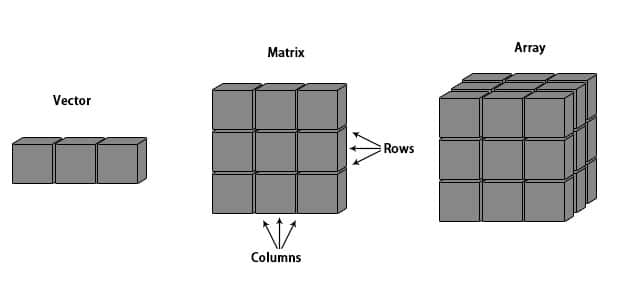Arrays in R Programming Language — Explained Simply
Arrays are data objects in the R programming language that can store data in more than two dimensions. For example, if we create an array of dimensions (2,3,4);
This array can then be used to create four rectangular matrices, each with two rows and three columns. Arrays can only store data types.
An array is created using the Array () function. This array accepts vectors as input and creates arrays; it uses values that are dimension parameters.
Example
The following example creates an array of three matrices, each with three rows and three columns.
# Create two vectors of different lengths. vector1 <- c (5,9,3) vector2 <- c (10,11,12,13,14,15) # Take these vectors as input to the array. result <- array (c (vector1, vector2), dim = c (3,3,2)) print (result)
When we run the above code, the following results are generated:
,, 1 [, 1] [, 2] [, 3] [1,] 5 10 13 [2,] 9 11 14 [3,] 3 12 15 ,, 2 [, 1] [, 2] [, 3] [1,] 5 10 13 [2,] 9 11 14 [3,] 3 12 15
Names of rows and columns
We can arrange rows, columns, and matrices within an array; Assign the desired name using the dimnames parameter.
# Create two vectors of different lengths. vector1 <- c (5,9,3) vector2 <- c (10,11,12,13,14,15) column.names <- c (“COL1 ″,” COL2 ″, ”COL3”) row.names <- c (“ROW1 ″,” ROW2 ″, ”ROW3”) matrix.names <- c (“Matrix1 ″,” Matrix2 ”) # Take these vectors as input to the array. result <- array (c (vector1, vector2), dim = c (3,3,2), dimnames = list (row.names, column.names, matrix.names)) print (result)
When we run the above code, the following results are generated:
,, Matrix1 COL1 COL2 COL3 ROW1 5 10 13 ROW2 9 11 14 ROW3 3 12 15 ,, Matrix2 COL1 COL2 COL3 ROW1 5 10 13 ROW2 9 11 14 ROW3 3 12 15
Access array members
# Create two vectors of different lengths. vector1 <- c (5,9,3) vector2 <- c (10,11,12,13,14,15) column.names <- c (“COL1 ″,” COL2 ″, ”COL3”) row.names <- c (“ROW1 ″,” ROW2 ″, ”ROW3”) matrix.names <- c (“Matrix1 ″,” Matrix2 ”) # Take these vectors as input to the array. result <- array (c (vector1, vector2), dim = c (3,3,2), dimnames = list (row.names, column.names, matrix.names)) # Print the third row of the second matrix of the array. print (result [3,, 2]) # Print the element in the 1st row and 3rd column of the 1st matrix. print (result [1,3,1]) # Print the 2nd Matrix. print (result [,, 2])
When we run the above code, the following result is obtained:
COL1 COL2 COL3 3 12 15 [1] 13 COL1 COL2 COL3 ROW1 5 10 13 ROW2 9 11 14 ROW3 3 12 15
Employ array members
As arrays are made of matrices with different dimensions, Operations on elements are performed by accessing matrix members.
# Create two vectors of different lengths. vector1 <- c (5,9,3) vector2 <- c (10,11,12,13,14,15) # Take these vectors as input to the array. array1 <- array (c (vector1, vector2), dim = c (3,3,2)) # Create two vectors of different lengths. vector3 <- c (9,1,0) vector4 <- c (6,0,11,3,14,1,2,6,9) array2 <- array (c (vector1, vector2), dim = c (3,3,2)) # create matrices from these arrays. matrix1 <- array1 [,, 2] matrix2 <- array2 [,, 2] # Add the matrices. result <- matrix1 + matrix2 print (result)
When we run the above code, we get the following result:
[, 1] [, 2] [, 3] [1,] 10 20 26 [2,] 18 22 28 [3,] 6 24 30
Computations on arrays of members
Using the apply() function, we can perform calculations on the members of an array.
Syntax
apply (x, margin, fun)
The parameters that we write in the above code are as follows:
- x is an array.
- Margin is the name of the data set used.
- Fun is a function that must be applied to members of an array.
Example
In the following code, we use the apply() function to calculate the sum of the elements in the rows of all matrices in an array.
# Create two vectors of different lengths. vector1 <- c (5,9,3) vector2 <- c (10,11,12,13,14,15) # Take these vectors as input to the array. new.array <- array (c (vector1, vector2), dim = c (3,3,2)) print (new.array) # Use apply to calculate the sum of the rows across all the matrices. result <- apply (new.array, c (1), sum) print (result)
When we run the above code, we achieve the following results:
,, 1 [, 1] [, 2] [, 3] [1,] 5 10 13 [2,] 9 11 14 [3,] 3 12 15 ,, 2 [, 1] [, 2] [, 3] [1,] 5 10 13 [2,] 9 11 14 [3,] 3 12 15 [1] 56 68 60
FAQ
What is an array in R?
An array in R is a multi-dimensional data structure where all elements are of the same type, typically used for matrices or higher dimensions.
How do I create a 3D array in R?
Use the array() function with a dim argument, e.g. my_array <- array(1:24, dim = c(2,3,4)).
How do I access elements of an array?
Use square brackets with indices for each dimension, e.g. my_array[1,2,3] to get the element at position (1, 2, 3).
